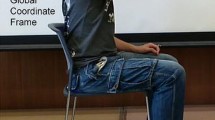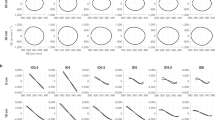Summary
In this study we investigated pointing movements made with an extended arm. Despite the large number of mechanical degrees of freedom, limb orientation adopted during pointing could be described by rotation axes contained on a two-dimensional curved surface. As a result of the curvature, the orientation of a linear plane approximating a small region of the curved surface was dependent on the location of the movements within the full workspace. These results account for earlier suggestions that limb orientation could be described by coplanar rotation vectors and that the orientation of the plane moved with the workspace. Despite the additional complexity, our results indicate that the number of degrees of freedom used to position the extended forearm is reduced from four to two for normal pointing movements. Contributions to orientation of the wrist and hand by supination/pronation of the forearm were minor for changes in shoulder yaw angle. However, supination/ pronation added significantly to orientation of the hand for changes in shoulder pitch angle.
Similar content being viewed by others
References
Caminiti R, Johnson PB, Urbano A (1990) Making arm movements within different parts of space: dynamic aspects in the primate motor cortex. J Neurosci 10: 2039–2058
Carpenter RHS (1977) Movements of the eyes. PION, London
Crawford JD, Vilis T (1991) Axes of rotation and Listing's law during rotations of the head. J Neurophysiol 3: 407–423
Donders FC (1848) Beitrag zur Lehre von den Bewegungen des menschlichen Auges. Holland Beitr Anat Physiol Wiss 1: 104–145
Georgopoulos AP, Kalaska JF, Caminiti R, Massey JT (1982) On the relations between the direction of two-dimensional arm movements and cell discharge in primate motor cortex. J Neurosci 2: 1527–1537
Georgopoulos AP, Kettner RE, Schwartz AB (1988) Primate motor cortex and free arm movements to visual targets in three-dimensional space. II. Coding of the direction of movement by a neuronal population. J Neurosci 8: 2928–2937
Haustein W (1989) Considerations on Listing's law and the primary position by means of a matrix description of eye position control. Biol Cybern 60: 411–420
Helmholtz H von (1866) Handbuch der physiologischen Optik. Voss, Hamburg. Translation (1962) Helmholtz' treatise on physiological optics. Dover, New York
Hepp K, Haslwanter T, Straumann D, Hepp-Reymond M-C, Henn V (1991) The control of arm, gaze and head by. Listing's law. In: Caminiti R (ed) Control of arm movement in space: neurophysiological and computational approaches. Springer, Berlin Heidelberg New York (Exp Brain Res Suppl)
Hore J, Goodale M, Vilis T (1990) The axis of rotation of the arm during pointing. Soc Neurosci Abstr 16: 1086
Kalaska JF, Caminiti R, Georgopoulos AP (1983) Cortical mechanisms related to the direction of two-dimensional arm movements: relations in parietal area 5 and comparison with motor cortex. Exp Brain Res 51: 247–260
Leigh RJ, Maas EF, Grossman GE, Robinson DA (1989) Visual cancellation of the torsional vestibulo-ocular reflex in humans. Exp Brain Res 75: 221–226
Nakayama K (1975) Coordination of extraocular muscles. In: Lennerstrand G, Bach-y-Rita P (eds) Basic mechanisms in ocular motility and their clinical implications. Pergamon Press, New York, pp 193–207
Straumann D, Hepp K, Hepp-Reymond M-C, Haslwanter T (1990) Human eye, head and arm rotations during reaching and grasping. Soc Neurosci Abstr 16: 1087
Straumann D, Haslwanter T, Hepp-Reymond M-C, Hepp K (1991) Listing's law for eye, head and arm movements and their synergistic control. Exp Brain Res 86: 209–215
Tweed D, Vilis T (1987) Implications of rotational kinematics for the oculomotor system in three dimensions. J Neurophysiol 58: 832–849
Tweed D, Vilis T (1990) Geometric relations of eye position and velocity vectors during saccades. Vision Res 30: 111–127
Author information
Authors and Affiliations
Rights and permissions
About this article
Cite this article
Miller, L.E., Theeuwen, M. & Gielen, C.C.A.M. The control of arm pointing movements in three dimensions. Exp Brain Res 90, 415–426 (1992). https://doi.org/10.1007/BF00227256
Received:
Accepted:
Issue Date:
DOI: https://doi.org/10.1007/BF00227256




